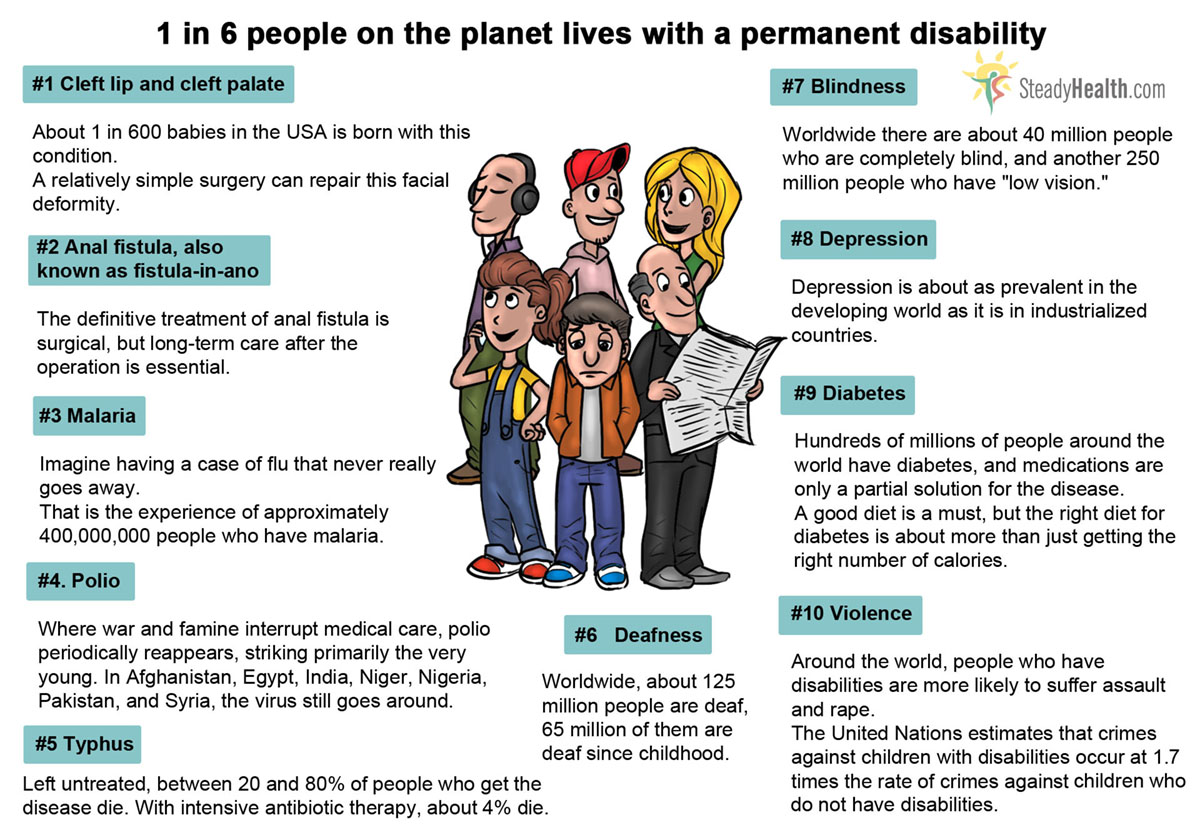Table of Contents
Health officials affiliated with the United Nations tell us that over a billion people worldwide live with a serious disability, but the most serious disabilities are often conditions that people in the developed world never hear about.
1. Cleft lip and cleft palate
A cleft is a separation of the lip or palate from the roof of the mouth. The cleft can affect either the lip or the palate, or both. Baby boys with the condition are most often born with both cleft lip and cleft palate, but baby girls with the condition are most commonly born with a normal lip and only a cleft palate.
A relatively simple surgery can repair this facial deformity, but in much of the world it is simply not available. Additional procedures may be required as the child grows to improve speech, dental alignment, and overall facial appearance. Speech therapy is often recommended to address any speech difficulties. Organizations like Smile Train recruit doctors to perform corrective surgeries for free around the world.
2. Anal fistula, also known as fistula-in-ano
An anal fistula is a essentially a second anus formed by the erosion of tissue between the rectum and the skin. It makes personal hygiene difficult, and as a result, people who have anal fistula often have to lead their lives in isolation, excluded from work and social opportunities.
Millions of women are believed to suffer this condition in sub-Saharan Africa, although exact counts have not been made.
The definitive treatment of anal fistula is surgical, but long-term care after the operation is essential. Common surgical options include fistulotomy (cutting open the entire fistula tract), fistulectomy (removal of the fistula tract), seton placement (placing a thread-like material to help drain the fistula and keep it open), and more advanced techniques such as fistula plug or advancement flap procedures.
Because of the location of the lesion, antibiotics are essential, and most patients also need some kind of ongoing anti-inflammatory medication. In the United States, the drugs most commonly prescribed after the surgery cost tens of thousands of dollars per year. In the developing world, treatment is extremely difficult.
3. Malaria
That is the experience of approximately 400,000,000 people who have malaria. One of the major challenges in treating malaria is that it usually takes a combination of drugs to get rid of the malaria parasite, and serious complications have to be treated with drugs administered by IV. Still, progress is being made in treating this incredibly common parasitic infection.
Preventive measures are essential for reducing the risk of malaria. These include taking antimalarial medications before, during, and after travel to endemic areas, using insect repellents, wearing protective clothing, sleeping under bed nets treated with insecticide, and avoiding mosquito bites, particularly during peak mosquito activity times.
A malaria vaccine called RTS,S/AS01, also known as Mosquirix, has been developed and is being piloted in some countries. It provides partial protection against malaria in young children but is not yet widely available.
Read More: Polio (PPS): Symptoms & Treatment
4. Polio
Fifty years ago, just about everyone knew someone who had had polio. While most people survived the disease, they might be left with limbs that just didn't work, because of the destruction of nerve tissue. And the symptoms of the disease might only show up 10, 20, 30, or even 40 years after the initial infection.
Polio is prevented by innoculation, but it has never completely disappeared.
In the seven countries where the virus still goes around, Afghanistan, Egypt, India, Niger, Nigeria, Pakistan, and Syria, every year hundreds to thousands of children are struck by the disease. Only a majority die or suffer permanent disability, but even these few deaths and disabilities are preventable.
Vaccination is the most effective way to prevent polio. The oral polio vaccine (OPV) and the inactivated polio vaccine (IPV) are used for immunization. Routine vaccination with multiple doses is recommended to provide long-lasting immunity.
- Cox-Singh J, Davis TM, Lee KS, Shamsul SS, Matusop A, Ratnam S, et al. Plasmodium knowlesi malaria in humans is widely distributed and potentially life threatening. Clin Infect Dis. Jan 15 2008. 46(2):165-71.
- Dionisopoulos T, Williams HB. Congenital anomalies of the Ear, Nose and Throat. New York: Oxford University Press, 1997:243-62.
- Mindmap by steadyhealth.com
- Photo courtesy of Ed Yourdon by Flickr : www.flickr.com/photos/yourdon/2987128975/



Your thoughts on this